KT Gun in a Million
Brindle in Horses
The brindle color pattern does not often occur in horses. The only mutation in horses that reliably produces a brindle coat color is now known to be associated with skin and other health problems and to be lethal in male foals.
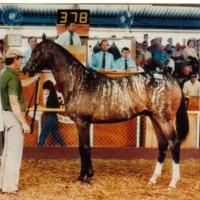
Catch A Bird A well known Thoroughbred stallion whose unique brindle pattern is thought to be the result of a misplaced white pattern. Interesting enough he is also founder of a line of roan Thoroughbreds
KT Gun in a Million
Then we have KT Gun in a Million. Born on May 23, 2014, she is by KT Gunpowder N Lead and out of Wright on Sugarnic and bred by the KT Ranch. She has been tested by UC Davis and her color can not be explained by chimerism. She has tested positive for roan but unlike other “brindle” roans, her unique pattern is not the result of white hairs but rather a mixture of what appears to be black and yellow. She has also tested negative for dun. Her coat color has been tested to be smoky black (Ee aa CrN).
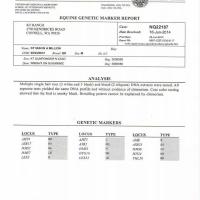
Test results for KT Gun in a Million. These show that she tested as non-chimeric even though both yellow and black hairs were tested
Somatic Mutation?
So, what is the cause of her unique color pattern? The answer is we don’t know. It is possible that a somatic mutation occurred very early in her development. (A somatic mutation is any mutation that occurs in the cells of a developing or adult individual.) If such a mutation occurred, it could possibly switch Extension (E) off in swatches thus causing her unusual coat color. The recessive allele at extension (e), effectively “breaks” extension making it impossible for the horse to produce black pigment. Because “KT Gun” is Ee, a mutation in extension on her “E” could “break” her remaining “E” allele making some areas of her coat effectively ee. Since this would likely be a different mutation then the well known recessive allele (e), it would not “show up” in a test for extension meaning she would still test Ee, even in the yellow areas. The result would effectively be a mix of Smoky Black and Palomino. If her unique coloring is the result of a somatic mutation she is still unique in that somatic mutations, even large ones rarely cover so much of an animal.
De Novo Mutation
Another possibly is a De Novo mutation. De Novo mutations are new mutations that affect the egg or sperm cell or that occur just after fertilization. Because of this, they affect every cell in the body and will be inheritable. De Novo mutations are rare and most of these are not visible. However, those affecting coat color do occur. One example is the Puchilingui line of Thoroughbreds. Born in 1984 Puchilingui was the founder of the W5 mutation found in Thoroughbreds. These Thoroughbreds are often called “Sabino” or “Dominant White” and have a white pattern that did not exist until Puchilingui was born. Her odd coat color pattern, however, makes a De Novo mutation unlikely as they do affect every cell. Most De Novo mutations that affect color, will result in either a white pattern or a solid colored animal with a unique color.
However, there are exceptions. One such exception occurs in cats: Orange. This mutation occurs on the x Chromosome in cats and as a result all male cats who carry the mutation will be Orange (aka Ginger). However, females that only carry one copy of this mutation are not one solid color.
How do we know?
So which is it? Is she the result of an early somatic mutation or a De Novo mutation? Well, at this point we don’t know and, truth be told, we may never know. UC Davis is continuing their investigation and hopefully will find the answer. Right now, it seems either possibility is as likely (or unlikely) as the other. Either way, KT Gun in a Million, is a unique individual, truly “one in a million”.


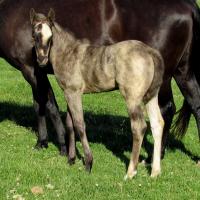

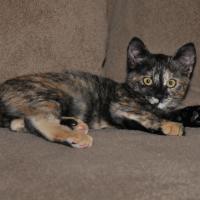
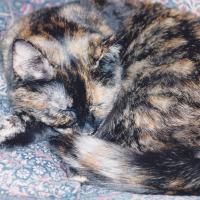


There has been some confusion
There has been some confusion that "KT Gun" is related to the Inheritable Brindle mentioned in the article. She is not. I mentioned the inheritable brindle as a comparison to KT Gun. She is something different. We just don't know what as of yet.